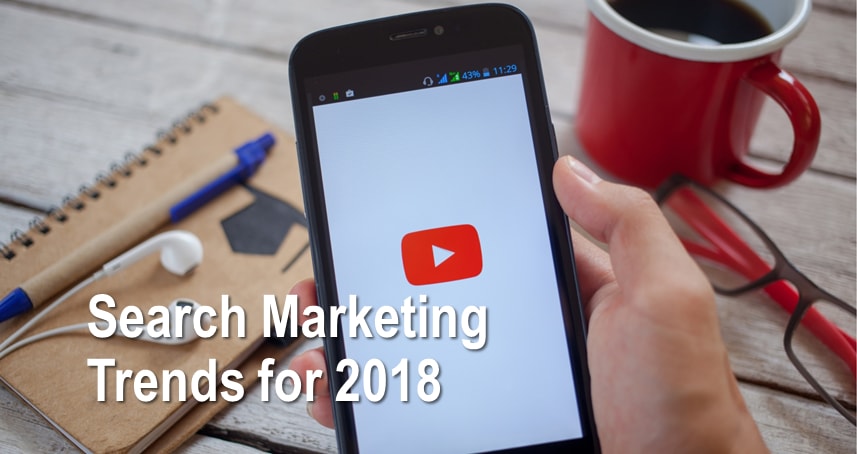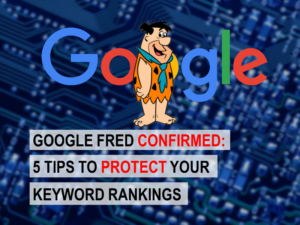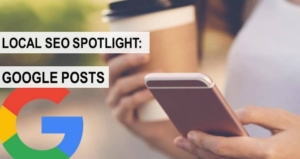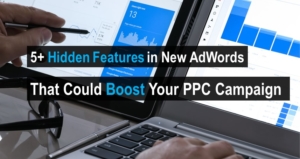Search marketing is ever-evolving. New technology shapes consumer behavior, impacting the way people search for products and services. Search engines respond to consumer behavior multiple times per day with upgrades to their platform. In order to grow your business through search, it is imperative to understand how these trends will impact the future and get help from professional SEO services.
As leading digital marketers with premier SEO services, we reflect on today’s landscape to determine the best long-term strategy for our clients. The following trends forecasted last year are today’s mainstays in search.
Search Marketing Trends Noticed by Professional SEO Services
1. RankBrain
In 2017, RankBrain came up as the new buzzword, replacing mobile-first and HTTPS topics. This news about Google’s new calibration of its ranking algorithm sparked a lot of discussion about Artificial Intelligence Optimization (AIO). RankBrain applies machine learning to rank sites based on adherence to Google’s best practices.
Approximately 15% of all searches are new to Google.
In every search among millions of searches, Google aims to deliver users the most relevant results for these new search terms. Google uses RankBrain to determine what a user is looking for. RankBrain takes into account a user’s past searches and behavior, similar searches performed by other users and their behavior, and other websites visited, to determine what results a user would like to see for their given search term (keyword). Google’s algorithm now interprets the searcher’s query, determines their intent, and then shows them the pages it thinks will be relevant based on all the previously collected data.
The main difference pre- and post-RankBrain is that software engineers would have to add updates to Google’s algorithm manually, which can take time to process, and would remain constant until the next update. Now, RankBrain is part of the core algorithm, so it can respond to world events and news in a timely manner, but this also makes it more volatile to big algorithm updates.
Although Google has made it plenty clear that websites should be optimized for users and not search engines, you should still be sure to discuss this with your SEO team and ensure that they continue to consider RankBrain as part of their strategy and action plan.
2. Google Fred
In addition to RankBrain, Google introduced another major algorithm update in March 2017. This algorithm appeared to further the core Google Penguin algorithm, targeting websites that fail to heed Google’s SEO guidelines. 95% of sites affected had “low quality” content, meaning it was written for ranking purposes instead of readers and contained heavy advertisements. Also affected were sites that had “low-quality” backlinks, directed from spammy websites.
If you were unaware of Google Fred, and your business has been on the decline since Q1 2017, there are steps you can take to regain your rankings. For these steps and more, check out our Google Fred blog.
3. Local Search (Boosted by Professional SEO Services)
According to Google, around one in five searches relates to location.
Google aims to provide locally relevant search results in order to serve the most accurate information to its users. This has an obvious impact to businesses that compete locally.
Because location is so prevalent in search behavior, Google enhanced several of its local tools to support both their users and local business owners. Google My Business, formerly Google Places, is now the one-stop-shop for local business owners to control their listing on Google (no longer relying on Google +).
In 2017, Google introduced many new GMB features that are free to use. These aim to help brick-and-mortar stores engage digital users and guide them to your location. The following features are extensions of your brand page when a user finds your business listing on Google:
- Google Posts shares timely content with your customers such as events, promotions, and exclusives. Visit our blog for more information on Google Posts and best practices.
- Q&A addresses frequently asked questions before customers even visit your site.
- Chat allows customers to message your business in real time, straight from Google.
Google also offers local search opportunities through paid advertising. AdWords now allows advertisers to pay for Google Maps rankings with “local search ads”. Previously, Google Maps rankings were solely attained through organic search, but can now be accessed through PPC. Now, search queries with high-intent may have four Maps listings, one paid ad followed by three organic listings. All results in the top four Maps listings enjoy the following benefits:
- Get more store visits. Don’t miss out on foot traffic nearby your location.
- Get calls. Local search ads can include an option for users to call your locations.
- Help customers learn more about your business. Local search ads link to your business’s location page, which includes information such as store hours, address, customer reviews, and photos.
4. New Google AdWords
Google AdWords made some long-anticipated changes to their entire interface in 2017, bringing a set of new tools, and improvements made upon existing tools. These tools have made it that much easier to manage your PPC campaigns and allow for many more options to fine-tune the performance so you can reach exactly the audience you need.
The user interface itself has been completely reworked: it looks much cleaner and is better organized and easier to read. The campaign summary page gives you quick access to a lot of very helpful information, including clicks and conversions by device, clicks, and conversions by time of day, and an easily changed graph charting any of the major performance metrics. The audience targeting options have also been updated to be easier to use and to target more precisely.
They’ve also brought some entirely new features in. One very useful tool for advertisers is the auction insights tool which gives you information on how you’re stacking up against your competitors in the bids. You can compare data like impression share, top-of-page rate, and average position, all of which can help you make advantageous changes to your campaign so that you’re outperforming those competitors.
AdWords also added a brand new promotion extension that allows you to showcase special sales and deals. Rather than put that information in the ad copy, the extension allows you to list promotions in several ways, including a percent discount and a static monetary discount. AdWords data shows that these new promotion extensions have the highest click-through rate of all the available extensions.
For more information on the new, hidden features of AdWords, read our New AdWords blog.
5. Influencer Marketing
Influencer marketing has become an essential part of reaching your audience.
74% of people turn to social networks for guidance on purchase decisions.
Through social networks, word-of-mouth recommendations and criticisms now spread faster than ever. With large and active social media followings, influencers can act as brand advocates and niche promoters for your business.
Consumers trust recommendations from a third party more often than a brand itself. When you engage an influencer, they deliver your brand message to their audience and their audience’s network. With a loyal audience, an influencer has the ability to drive traffic to your site, increase your social media exposure, and increase conversions through their recommendation.
How do influencers impact search marketing? Once engaging with an influencer, they begin generating content about your brand, bringing backlink opportunities to your website. Search engines favor sites that are referenced outside of their own website. To the search engines, this external content demonstrates higher authority, just as it represents higher reputation/trustworthiness for a consumer.
Professional SEO Services Predictions for 2018
If this is where we are today, what emerging trends are certain to impact buyer behavior in the future? As we know, technology shapes buyer behavior, which in turn impacts search behavior. If you aim to grow your business in 2018, you will need to incorporate the following into your marketing strategy and get help from professional SEO services.
6. Video Marketing
Video marketing is accelerating each year as companies seek to better cater to millennials and beyond.
YouTube has now surpassed Google as the most popular search engine based on number of monthly users, and there are over one billion hours of video watched on YouTube every day.
Video content is more prevalent as a marketing technique than you may think. More than half of businesses say they create video content at least once a week, and 26% said they create video content daily. On average, each American business will spend $20,000 on video marketing this year according to a Forbes study.
There are many ways to utilize video content but not all techniques are appropriate for all industries. E-commerce can benefit from short videos on a product page to display how the product works or show off unique features.
Projection mapping displays a 2D video onto a 3D surface, such as the side of a building. This type of video marketing is often used for large-scale events, like product launches and outdoor events. Viewers can take pictures, videos, or live stream the show, and create social media buzz around your business.
Live streaming has become even more prevalent over the past few years with YouTube Live, Facebook Live, Periscope, and now Instagram Live. Live streaming has even become an interactive experience with users able to “like”, “love”, or send emojis and comments to the broadcaster.
Another immersive video marketing strategy is 360 Videos. These videos allow users to take a 360-degree view of a store, landscape, or event. People can travel to distant locations of the world without leaving their chair. Or, they can go shopping for furniture and see how it will look in their own home.
Increase your conversion rate among digital native generations with a video marketing strategy for 2018 from professional SEO services.
7. Social Media on the Rise
It’s well known that video has taken over social media. It’s very common to scroll through a Facebook feed and see at least eight or ten video advertisements. Need help creating social media posts? SEO services can help.
Facebook hosts 8 billion video views each day.
They were pioneers for live streaming video early in 2016 which gave viewers the most profound experience of that year: Chewbacca Mom sharing the joys of life. Instagram, YouTube, and Twitter followed suit launching live streaming into a profitable marketing tool for businesses.
Consumers want original, dazzling, and easily digestible content usually no more than thirty seconds long. As mobile has taken over as the primary way we view social media, people want content that they can watch while they’re standing in line, bored at work, or getting ready for bed. Businesses have to be in tune with their audience to create content consumers will not only be engaged in while scrolling, but share and talk about later. Expand your reach by touching base with prospective customers before, during, and after the live stream.
So what are the major implications that live streaming has for businesses? Consumers want content that is accessible. Easy broadcasting increases the amount of video on any given platform. They want their content anytime, anywhere. The average adult consumes more than five hours of video per day and more than one hour is on digital devices. Don’t snooze on your video marketing strategy in 2018. Get help with professional SEO services.
8. Voice Search & Digital Assistants
According to Google, more than half of teens and 41% of adults use voice search daily.
Experts predict that more than half of all queries will be voice search by 2020. The voice search trend makes sense. With the rise of Google Home, Alexa, and mobile as the dominant ways we interact with the internet, voice search is quickly becoming a more intuitive means of how the consumer finds exactly what they need. You’ve likely used this technology in your own life already.
“Siri, what is the highest rated Italian restaurant near me?”
“Alexa, where is the nearest place I can buy a new taillight?”
“Hey Google, what is the best holiday cookie recipe?”
The evolution of voice search has far reaching implications for businesses as well as consumers. Voice search uses more question words than text search and requires native language optimization. It also demands a high volume of quality, valuable, and unique content. Furthermore, 22% percent of voice searches are used to get local information. Local search optimization requires identification and optimization of long tail keyword phrases when building content. Businesses will need to tighten up their online presence by updating and adhering to standardized structured data formats (local business information data, product catalogs, etc).
Optimized local listings also impact voice search results, factoring in incomplete, missing, or duplicate listings. To top it all off, for those who are multilingual, Google is updating its Google Assistant to recognize multiple languages. Instead of only setting your voice recognition to one language, a person who is bilingual can now use two or three languages. In a diversifying market, this could have strong implications in search. Another Google game changer? Google Assistant will be able to tell a consumer how much of a product a business has in stock.
10. Programmatic Advertising & Artificial Intelligence
Artificial intelligence has made huge strides in the past few years, and it’s not going anywhere anytime soon. Artificial intelligence is a computer-driven task that historically would have been considered something only a human could do well. A growing number of companies are exploring AI for optimally effective marketing. We’ve entrusted more and more tasks to computers, and advertising is no different. However good your campaign manager is, there are some things that only a computer can do.
There are a few major applications for businesses, including the ability to create highly effective ads, produce high-quality content, and analyze your target customers with the help of professional SEO services.
Programmatic advertising, in particular, gives marketers some highly effective tools for reaching potential customers. This form of marketing automation can streamline the ad buying process with data-driven technology that an AI uses to make decisions. Experts are predicting that almost 70% of B2B marketers plan to increase spending on programmatic ads in 2018 and beyond.
Pursuing this form of advertising means that purchasing ads becomes more reliable and less costly since you’re not spending as much money on ads that don’t perform well. You can generate greater insights into consumer behavior, allowing you to set precise KPIs. AI-assisted advertising also enables much better targeting of prospective customers and better quality conversions as a result.
Award-Winning SEO Services
Don’t miss out on trends that will shape your SEO strategy for 2018. If your SEO strategy isn’t ready for the future, are you prepared to lose your site traffic and web leads? Give us a call at 404.751.1043 or use our contact form to learn more about how our SEO services have brought success to businesses just like yours.




